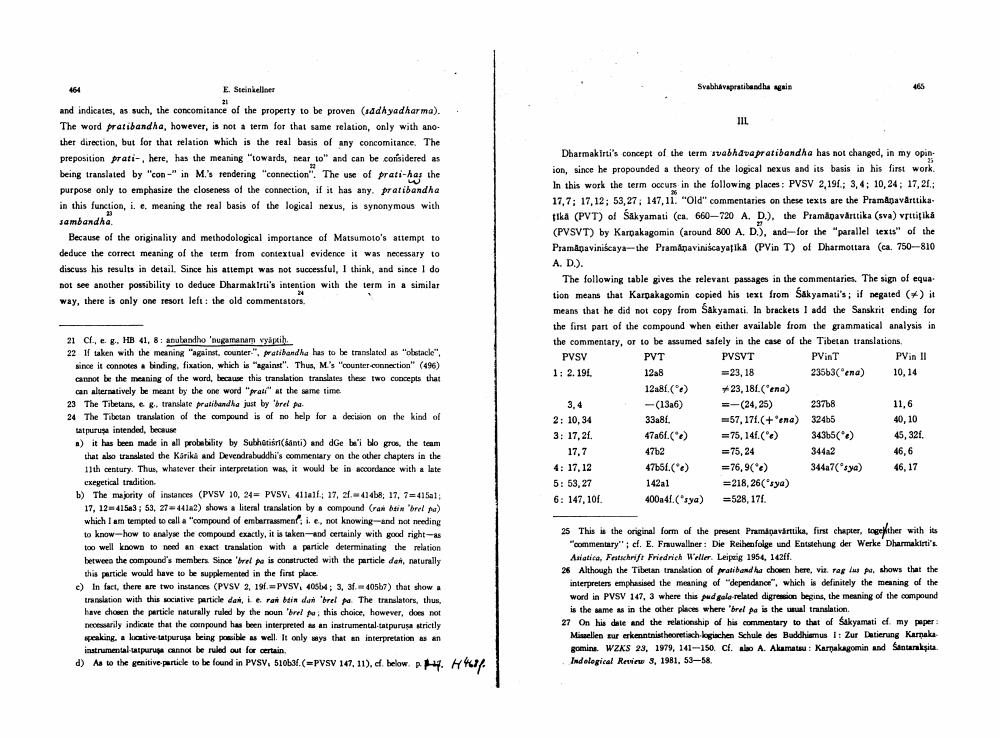________________
E Sebeller
Svabhavaratibandha again
.
IIL
and indicates, as such, the concomitance of the property to be proven (sadhyadharma). The word pratibandha, however, is not a term for that same relation, only with another direction, but for that relation which is the real basis of any concomitance. The preposition prati-, here, has the meaning towards, tear_to" and can be considered as being translated by "con-" in M's rendering connection". The use of prati-has the purpose only to emphasize the closeness of the connection, if it has any pratibandha in this function, i. e, meaning the real basis of the logical nexus, is synonymous with sambandha.
Because of the originality and methodological importance of Matsumoto's attempt to deduce the correct meaning of the term from contextual evidence it was necessary to discuss his results in detail. Since his attempt was not successful, I think, and since I do not see another possibility to deduce Dharmak Irti's intention with the term in a similar way, there is only one resort left: the old commentators.
Dharmakirti's concept of the term vabhava pratibandha has not changed, in my opin ion, since he propounded a theory of the logical nexus and its basis in his first work In this work the term occurs in the following places: PVSV 2,191; 3,4; 10,24; 17, 21; 17,7; 17,12; 53,27; 147, 11. "Old"commentaries on these texts are the PramAnavarttika tika (PVT) of Sikyamati (ca. 660-720 A.D.), the Pramkoavarttika (sva) vilka (PVSVT) by Karpakagomin (around 800 A. D), and for the "parallel texts" of the Pramanaviniscaya- the Pramimaviniscayafika (PVin T) of Dharmottara (ca. 750-810 A. D.).
The following table gives the relevant passages in the commentaries. The sign of equa tion means that Karpakagomin copied his text from Sakyamati's; il negated in means that he did not copy from Sakyamati. In brackets I add the Sanskrit ending for the first part of the compound when either available from the grammatical analysis in the commentary, or to be assumed salely in the case of the Tibetan translations PVSV PVT PVSVT PVint
PV in 11 1: 2. 191. 12a8 23, 18
235b3(ena) 10,14 12481 () 23, 181("ena) -(1326) --(24, 25) 237b8
11,6 2: 10,34
33a81. -57, 171.(+'ena) 324b5
40,10 3: 17,21. 47a6l.(*) 75,141.(.) 34365(e) 45,326. 17,7 472 75,24 344a2
46,6 4: 17.12
47b51.(e) =76,9(e) 344a7(sya) 46,17 5: 53,27
142a1
= 218, 26('sya) 6: 147, 101 400a41. (sya) =528, 171
21 Ch., . , HB 41, 8: anulandho 'nugamanam vyrui 22 W taken with the meaning against counter". Wat handla has to be translated as "obstacle"
since it connotes a binding, fixation, which is against". Thus, M's "counterconnection" (496) cannot be the meaning of the word, because this translation translates these two concepts that
can alternatively be meant by the one word "all" at the same time 23 The Tibetans, & , translate pratibandha just by 'bral pa 24 The Tibetan translation of the compound is of me help for a decision on the kind of
at purus intended, because a) it has been made in all probability by Subhotinanti) and dGe b'i bo gros, the team
that also translated the Karikh and Devendrabuddhi's commentary on the other chapters in the 11th century. Thus, whatever their interpretation was, it would be in accordance with a late
exegetical tradition b) The majority of instances (PVSV 20, 24 PVSV, 411al: 17, 2-414be; 17, 7 = 415a1;
17, 12-41543; 53, 2744122) shows a literal translation by compound Gran lain 'bel pa) which I am tempted to call a compound of embarrassment.i. e, not knowing-and not needing to know-how to analyse the compound cctly, it is taken--and certainly with good right toe well known to need an exact translation with particle determinating the relation between the compound's members Sincerele is constructed with the particle den, naturally
this particle would have to be supplemented in the first place c) In fact, there are two instances (PVSV 2, 191PVSV, 40564; 3, 31, 40567) that show
translation with this writive particle danie rar in der Orel The translators, thus have chosen the particle naturally ruled by the soun d to this choice, however, does not necessarily indicate that the compound has been interpreted an instrumental-tatpurusa strictly
peaking, kative a r e being psible as well. It only ways that an interpretation as an instrumental a pure cannot be ruled out for certain d) As to the genitive particle to be found in PVSV, 5103(PVSV 14.11). of below . H
25 This is the original form of the present Pramagavartike, first chapter, together with its
"commentary"; d. E. Fruwallner: Die Reihenfolge und Entstehung der Werke Dharmakirti's
Asiatica, Fritschrift Friedrich Weller. Leipeg 1954, 142ff. 26 Although the Tibetan translation of patibond he chosen here, vitrag u pe shows that the
interpreters emphasised the meaning of dependence", which is definitely the meaning of the word in PVSV 147, 3 where this pagal related digree begins, the meaning of the compound
is the mess in the other places wherebral is the usual translation 27 On his date and the relationship of his commentary to that of Sakyamatid my peper
Mielien sur arkenntnistheoretischlagschen Schule des Baddhismus 1: Zur Datierung Karnaka gamine WZKS 23, 1979, 141-150. cl. o A. Alamatan : Kamakagomin and Santara kita Indological Review 3, 1981, 53-58.
a l




